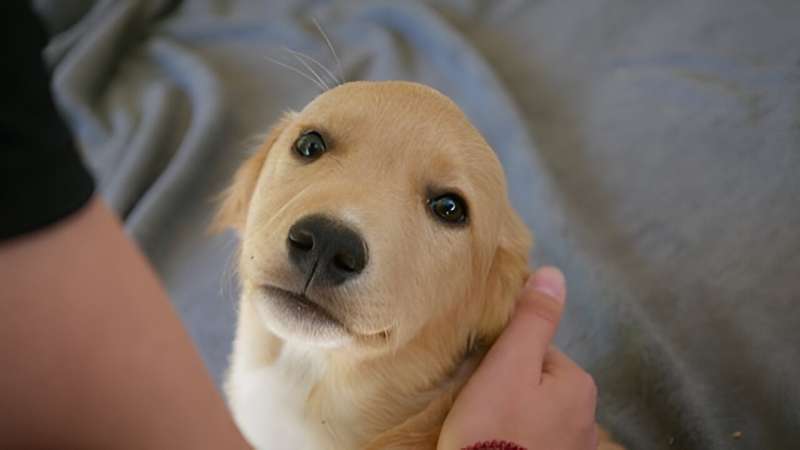This article has been reviewed according to Science X's editorial process and policies. Editors have highlighted the following attributes while ensuring the content's credibility:
fact-checked
peer-reviewed publication
trusted source
proofread
Chromatin structure found to play a key role in canine social behavior evolution

A study on dogs found that chromatin's spatial structure has a significant role in the evolution of social behavior. Chromatin, the compact form of DNA, not only packages genetic material but also plays a crucial role in gene regulation.
This study, published in BMC Genomics, demonstrates that both the linear sequence of DNA and its three-dimensional configuration are linked to friendly behavior shaped by dog domestication, providing new insights into the molecular mechanisms underlying social traits.
Behavioral traits such as sociability are influenced by numerous genes, their interactions, environmental factors, and individual life experiences.
Because the effect of a single gene is difficult to detect, it made headlines when, in 2017, Dr. Bridgett vonHoldt, a professor at Princeton University, and her team identified specific elements in the GTF2I gene in dogs, linked to Williams-Beuren syndrome (WB) in humans, characterized by hypersociability, extreme friendliness, and craniofacial abnormalities.
The findings suggested that the selection for increased friendliness in dogs involved changes in the GTF2I gene.
"This gene plays a role in neural development and pathways related to anxiety and sociability and is likely a key determinant of the friendly behavior shaped by domestication. In our current study, we aimed to investigate how genetic variants influence the 3D structure of the DNA containing this gene," says vonHoldt, lead author of the publication.
"The GTF2I gene has several variants, with the ancient, wolf-like variant found in three out of ten individuals. We were curious about how the ancient and more modern variants precisely affect gene function." The gene variants originate from retrotransposons, which are mobile, self-multiplying DNA elements.
The researchers examined an intronic section of the gene, which does not produce a gene product but likely influences chromatin—the complex of DNA and proteins that make up chromosomes—spatial structure and causes differences in gene expression.
They relied on brain tissue samples from dogs provided by the ELTE University's Canine Brain and Tissue Bank in Budapest.
"Brainstem samples were collected from pet dogs euthanized for medical reasons and donated for research. We included only dogs without major nervous system illnesses," explains Dr. Eniko Kubinyi, head of the Department of Ethology at ELTE, who established the bank with geneticist Dr. Sára Sándor and veterinarian Dr. Kálmán Czeibert and maintains it with grants from the Hungarian Academy of Sciences.
"The examined gene regulates the expression of other genes, so its expression is expected throughout the brain."
The study found that the ancient and modern variants of GTF2I affect the chromatin loop shape differently.
"Novel regulatory DNA segments caused by retrotransposon insertions are generally eliminated from the genome. Interestingly, within an intron of the GTF2I gene, the ancient wolf genome largely co-opts the inserted segment, while the modern dog genome rejects it," said Dr. Dhriti Tandon, the first author of the study.
"The presence or absence of this retrotransposon is associated with altered 3D chromatin structure at GTF2I, with possible downstream impacts on pathways regulating the extra-cellular matrix and GTF2I splicing.
"This is similar to the humans' case, where many WB patients have cranio-facial abnormalities explained by extra-cellular matrix anomalies and altered GTF2I function. Essentially, we report putative molecular convergence between hyper-social behavior in dogs and human Williams-Beuren syndrome."
When certain species preserve the same mutation while others do not—as seen in the difference between wolves and dogs—the regulatory effect is likely evolutionarily significant. In the absence of retrotransposons, a DNA loop present in wolves does not form in dogs, which may explain some of the differences in neurocognitive profiles and hence social behaviors between the two species.
The researchers hope that their results will highlight that not only the genomic base sequence, but also its 3D structure, influences behavior.
More information: Dhriti Tandon et al, Canine hyper-sociability structural variants associated with altered three-dimensional chromatin state, BMC Genomics (2024). DOI: 10.1186/s12864-024-10614-6
Journal information: BMC Genomics
Provided by Eötvös Loránd University





















